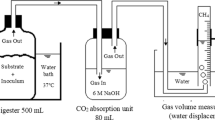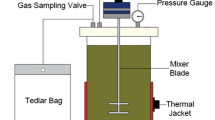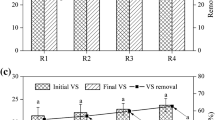Abstract
Anaerobic digestion (AD) is a sustainable wastewater treatment technology which facilitates energy, nutrient, and water recovery from organic wastes. The agricultural and industrial wastes are suitable substrates for the AD, as they contain a high level of biodegradable compounds. The aim of this study was to examine the AD of three different concentrations of phenol (100, 200, and 300 mg/L) containing wastewater with and without co-substrate (acetate) at four different temperatures (25, 35, 45, and 55 °C) to produce methane (CH4)-enriched biogas. It was observed that the chemical oxygen demand (COD) and phenol removal efficiencies of up to 76% and 72%, respectively, were achieved. The CH4 generation was found higher in anaerobic batch reactors (ABRs) using acetate as co-substrate, with the highest yield of 189.1 μL CH4 from 500 μL sample injected, obtained using 200 mg/L of phenol at 35 °C. The results revealed that the performance of ABR in terms of degradation efficiency, COD removal, and biogas generation was highest at 35 °C followed by 55, 45, and 25 °C indicating 35 °C to be the optimum temperature for AD of phenolic wastewater with maximum energy recovery. Scanning electron microscopy (SEM) revealed that the morphology of the anaerobic sludge depends greatly on the temperature at which the system is maintained which in turn affects the performance and degradation of toxic contaminants like phenol. It was observed that the anaerobic sludge maintained at 35 °C showed uniform channels leading to higher permeability through enhanced mass transfer to achieve higher degradation rates. However, the denser sludge as in the case of 55 °C showed lesser permeability leading to limited transfer and thus reduced treatment. Quantitative real-time PCR (qPCR) analysis revealed a more noteworthy change in the population of the microbial communities due to temperature than the presence of phenol with the methanogens being the dominating species at 35 °C. The findings suggest that the planned operation of the ABR could be a promising choice for CH4-enriched biogas and COD removal from phenolic wastewater.





Similar content being viewed by others
References
Ahammad SZ, Davenport RJ, Read LF, Gomes J, Sreekrishnan TR, Dolfing J (2013) Rational immobilization of methanogens in high cell density bioreactors. RSC Adv 3:774–781
Ahmad SA, Shamaan NA, Arif NM, Koon GB, Shukor MYA, Syed MA (2012) Enhanced phenol degradation by immobilized Acinetobacter sp. strain AQ5NOL 1. World J Microbiol Biotechnol 28:347–352
American Public Health Association, American Water Works Association, United States. Environmental Protection Agency, Water Pollution Control Federation, (2017) Standard methods for the examination of water and wastewater
Anwer AH, Khan MD, Khan N, Nizami AS, Rehan M, Khan MZ (2019) Development of novel MnO2 coated carbon felt cathode for microbial electroreduction of CO2 to biofuels. J Environ Manag 249:109376
Banu JR, Sugitha S, Kannah RY, Kavitha S, Yeom IT (2018) Marsilea spp.—a novel source of lignocellulosic biomass: effect of solubilized lignin on anaerobic biodegradability and cost of energy products. Bioresour Technol 255:220–228
Cavinato C, Da Ros C, Pavan P, Cecchi F, Bolzonella D (2014) Treatment of waste activated sludge together with agro-waste by anaerobic digestion: focus on effluent quality. Water Sci Technol 69:525–531
Chen C-L, Wu J-H, Liu W-T (2008) Identification of important microbial populations in the mesophilic and thermophilic phenol-degrading methanogenic consortia. Water Res 42:1963–1976
Collins G, Foy C, McHugh S, Mahony T, O’Flahert V (2005) Anaerobic biological treatment of phenolic wastewater at 15–18 °C. Water Res 39:1614–1620
Connelly S, Shin SG, Dillon RJ, Ijaz UZ (2017) Bioreactor scalability: laboratory-scale bioreactor design influences performance, ecology, and community physiology in expanded granular sludge bed bioreactors. Front Microbiol 8:664
Da Ros C, Cavinato C, Pavan P, Bolzonella D (2017) Mesophilic and thermophilic anaerobic co-digestion of winery wastewater sludge and wine lees: an integrated approach for sustainable wine production. J Environ Manag 203:745–752
Fang HHP, Liang DW, Zhang T, Liu Y (2006) Anaerobic treatment of phenol in wastewater under thermophilic condition. Water Res 40:427–434
Gali VS, Kumar P, Mehrotra I (2006) Biodegradation of phenol with wastewater as a cosubstrate in upflow anaerobic sludge blanket. J Environ Eng ASCE 132:1539–1542
Gannoun H, Othman NB, Bouallagui H, Moktar H (2007) Mesophilic and thermophilic anaerobic co-digestion of olive mill wastewaters and abattoir wastewaters in an upflow anaerobic filter. Ind Eng Chem Res 46:6737–6743
Jayashree C, Arulazhagan P, Kumar SA, Kaliappan S, Yeom IT, Banu JR (2014) Bioelectricity generation from coconut husk retting wastewater in fed batch operating microbial fuel cell by phenol degrading microorganism. Biomass Bioenergy 69:249–254
Keith L, Telliard W (1979) ES&T special report: priority pollutants: I-a perspective view. Environ Sci Technol 13:416–423
Khan MZ, Khan F, Sabir S (2011a) Aerobic granular treatment of 2,4- dichlorophenol. Can J Chem Eng 89:914–920
Khan MZ, Mondal PK, Sabir S (2011b) Bioremediation of 2-chlorophenol containing wastewater by aerobic granules-kinetics and toxicity. J Hazard Mater 190:222–228
Khan MZ, Mondal PK, Sabir S, Tare V (2011c) Degradation pathway, toxicity and kinetics of 2,4,6-trichlorophenol with different co-substrate by aerobic granules in SBR. Bioresour Technol 102:7016–7021
Khan MZ, Singh S, Sreekrishnan TR, Ahammad SZ (2014) Feasibility study on anaerobic biodegradation of azo dye reactive orange 16. RSC Adv 4:46851–46859
Khan MD, Abdulateif H, Ismail IM, Sabir S, Khan MZ (2015a) Bioelectricity generation and bioremediation of an azo-dye in a microbial fuel cell coupled activated sludge process. PLoS One 10:e0138448
Khan MZ, Singh S, Sultana S, Sreekrishnan TR, Ahammad SZ (2015b) Studies on the biodegradation of two different azo dyes in bioelectrochemical systems. New J Chem 39:5597–5604
Khan MD, Khan N, Nizami AS, Rehan M, Sabir S, Khan MZ (2017) Effect of co-substrates on biogas production and anaerobic decomposition of pentachlorophenol. Bioresour Technol 238:492–501
Lefèvre S, Boutin O, Ferrasse JH, Malleret L, Faucherand R, Viand A (2011) Thermodynamic and kinetic study of phenol degradation by a non-catalytic wet air oxidation process. Chemosphere 84:1208–1215
Levén L, Schnürer A (2005) Effects of temperature on biological degradation of phenols, benzoates and phthalates under methanogenic conditions. Int Biodeterior Biodegrad 55:153–160
Levén L, Eriksson ARB, Schnürer A (2007) Effect of process temperature on bacterial and archaeal communities in two methanogenic bioreactors treating organic household waste. FEMS Microbiol Ecol 59:683–693
Levén L, Nyberg K, Schnürer A (2012) Conversion of phenols during anaerobic digestion of organic solid waste-a review of important microorganisms and impact of temperature. J Environ Manag 95:S99–S103
Li KY, Kuo CH, Weeks JL Jr (2004) A kinetic study of ozone-phenol reaction in aqueous solutions. AICHE J 25:583–591
Loh KC, Chung TS, Ang WF (2000) Immobilized-cell membrane bioreactor for high-strength phenol wastewater. J Environ Eng 126:75–79
Manojlovic D, Ostojic DR, Obradovic BM, Kuraica MM, Krsmanovic VD, Puric J (2007) Removal of phenol and chlorophenols from water by new ozone generator. Desalination 213:116–122
Monsalvo VM, Mohedano AF, Casas JA, Rodríguez JJ (2009) Cometabolic biodegradation of 4-chlorophenol by sequencing batch reactors at different temperatures. Biresour Technol 100:4572–4578
Nizami AS, Murphy JD (2011) Optimizing the operation of a two-phase anaerobic digestion system digesting grass silage. Environ Sci Technol 45:7561–7569
Nizami AS, Thamsiriroj T, Singh A, Murphy JD (2010) Role of leaching and hydrolysis in a two-phase grass digestion system. Energy Fuel 8:4549–4559
Nizami AS, Singh A, Murphy JD (2011) Design, commissioning, and start-up of a sequentially fed leach bed reactor complete with an upflow anaerobic sludge blanket digesting grass silage. Energy Fuel 25:823–834
Nizami AS, Orozco A, Groom E, Dieterich B, Murphy JD (2012) How much gas can we get from grass? Appl Energy 92:783–790
Nizami AS, Rehan M, Ismail IMI, Almeelbi T, Ouda OKM (2015a) Waste biorefinery in Makkah: a solution to convert waste produced during Hajj and Umrah seasons into wealth. 15th Sci. Symp. Hajj, Umr. Madinah Visit - Sci. Portal 1436AH, 27-28 May 2015
Nizami AS, Ouda OKM, Rehan M, El-Maghraby AMO, Gardy J, Hassanpour A et al (2015b) The potential of Saudi Arabian natural zeolites in energy recovery technologies. Energy. 108:162–171
Nizami AS, Rehan M, Ouda OKM, Shahzad K, Sadef Y, Iqbal T, Ismail, IMI (2015c) An argument for developing waste-to-energy technologies in saudi arabia. Chem Eng Trans. 45:337–342
Nizami AS, Shahzad K, Rehan M, Ouda OKM, Khan MZ, Ismail IMI et al (2016) Developing waste biorefinery in Makkah: a way forward to convert urban waste into renewable energy. Appl Energy 186:189–196
Ouda OKM, Raza SA, Nizami AS, Rehan M, Al-Waked R, Korres NE (2016) Waste to energy potential: a case study of Saudi Arabia. Renew Sust Energ Rev 61:328–340
Polymenakou PN, Stephanou EG (2005) Effect of temperature and additional carbon sources on phenol degradation by an indigenous soil pseudomonad. Biodegradation 16:403–413
Rabaey K, Boon N, Höfte M, Verstraete W (2005) Microbial phenazine production enhances electron transfer in biofuel cells. Environ Sci Technol 39:3401–3408
Rahman W, Khan MD, Khan MZ, Halder G (2018) Anaerobic biodegradation of benzene-laden wastewater under mesophilic environment and simultaneous recovery of methane-rich biogas. J Environ Chem Eng 6:2957–2964
Ramakrishnan A, Gupta SK (2008) Effect of hydraulic retention time on the biodegradation of complex phenolic mixture from simulated coal wastewater in hybrid UASB reactors. J Hazard Mater 153:843–851
Raposo F, De la Rubia MA, Fernández-Cegrí V, Borja R (2012) Anaerobic digestion of solid organic substrates in batch mode: an overview relating to methane yields and experimental procedures. Renew Sust Energ Rev 16:861–877
Sancinetti, G. P., Sader, L. T., Varesche, M. B. A., Amorim, E. L. C., Omena, S. P. F., & Silva, E. L. (2012). Phenol degradation in an anaerobic fluidized bed reactor packed with low density support materials. Brazilian Journal of Chemical Engineering, 29, 87–98.
Shen Y, Linville JL, Urgun-Demirtas M, Mintz MM, Snyder SW (2015) An overview of biogas production and utilization at full-scale wastewater treatment plants (WWTPs) in the United States: challenges and opportunities towards energy-neutral WWTPs. Renew Sust Energ Rev 50:346–362
Siggins A, Enright AM, O’Flaherty V (2011a) Low-temperature (7 °C) anaerobic treatment of a trichloroethylene-contaminated wastewater: microbial community development. Water Res 45:4035–4046
Siggins A, Enright AM, O’Flaherty V (2011b) Temperature dependent (37–15°C) anaerobic digestion of a trichloroethylene-contaminated wastewater. Bioresour Technol 102:7645–7656
Singh A, Nizami AS, Korres NE, Murphy JD (2011) The effect of reactor design on the sustainability of grass biomethane. Renew Sust Energ Rev 15:1567–1574
Sokkanathan G, Sharmila VG, Kaliappan S, Banu JR, Yeom IT, Rani RU (2018) Combinative treatment of phenol-rich retting-pond wastewater by a hybrid upflow anaerobic sludge blanket reactor and solar photofenton process. J Environ Manag 206:999–1006. https://doi.org/10.1016/j.jenvman.2017.11.083
Sultana S, Khan MD, Sabir S, Gani KM, Oves M, Khan MZ (2015) Bio-electro degradation of azo-dye in a combined anaerobic–aerobic process along with energy recovery. New J Chem 39:9461–9470
Tahir MS, Shahzad K, Shahid Z, Sagir M, Rehan M, Nizami AS (2015) Producing methane enriched biogas using solvent absorption method. Chem Eng Trans 45:1309–1314
Thamsiriroj T, Nizami AS, Murphy JD (2012) Why does mono-digestion of grass silage fail in long term operation. Appl Energy 95:64–76
Umaiyakunjaram R, Shanmugam P (2016) Study on submerged anaerobic membrane bioreactor (SAMBR) treating high suspended solids raw tannery wastewater for biogas production. Bioresour Technol 216:785–792
Wang W, Zhang J, Wang S, Shen J, Pan S-L (2014) Oxygen-limited aeration for relieving the impact of phenolic compounds in anaerobic treatment of coal gasification wastewater. Int Biodeterior Biodegradation 95:110–116
Wintsche B, Glaser K, Sträuber H, Centler F, Liebetrau J, Harms H et al. (2016) Trace elements induce predominance among methanogenic activity in anaerobic digestion 7:1–12
Wojcieszak M, Pyzik A, Poszytek K, Krawczyk PS, Sobczak A, Lipinski L et al (2017) Adaptation of methanogenic inocula to anaerobic digestion of maize silage. Front Microbiol 8:1–12
Xiao Y, De Araujo C, Sze CC, Stuckey DC (2015) Controlling a toxic shock of pentachlorophenol (PCP) to anaerobic digestion using activated carbon addition. Bioresour Technol 181:303–311
Xu X, Yi Z, Chen D, Duan X, Zhou Z, Fan X et al (2011) Evaluation of photocatalytic production of active oxygen and decomposition of phenol in ZnO suspensions. Rare Metals 30:188–191
Yeshanew MM, Frunzo L, Lens PNL, Pirozzi F (2016) Mass loss controlled thermal pretreatment system to assess the effects of pretreatment temperature on organic matter solubilization and methane yield from food waste 4:1–13
Yusoff N, Ong S-A, Ho L-N, Wong Y-S, Saad FNM, Khalik WF, Lee S-L (2019) Performance of the hybrid growth sequencing batch reactor (HG-SBR) for biodegradation of phenol under various toxicity conditions. J Environ Sci 75:64–72
Zhang F, Li M, Li W, Feng C, Jin Y, Guo X et al (2011) Degradation of phenol by a combined independent photocatalytic and electrochemical process. Chem Eng J 175:349–355
Acknowledgments
The authors are thankful to Aligarh Muslim University for providing necessary research facilities. MZK is also grateful to the Department of Biochemical Engineering and Biotechnology, IIT Delhi, for providing qPCR facilities.
Funding
MDK thanked the Council of Science and Technology, Uttar Pradesh, (CST/1585) for providing financial support in the form of Research Assistantships.
Author information
Authors and Affiliations
Corresponding authors
Additional information
Responsible editor: Ta Yeong Wu
Publisher’s note
Springer Nature remains neutral with regard to jurisdictional claims in published maps and institutional affiliations.
Electronic supplementary material
ESM 1
(DOCX 291 kb)
Rights and permissions
About this article
Cite this article
Khan, N., Khan, M.D., Sabir, S. et al. Deciphering the effects of temperature on bio-methane generation through anaerobic digestion. Environ Sci Pollut Res 27, 29766–29777 (2020). https://doi.org/10.1007/s11356-019-07245-w
Received:
Accepted:
Published:
Issue Date:
DOI: https://doi.org/10.1007/s11356-019-07245-w




